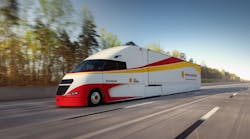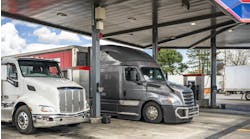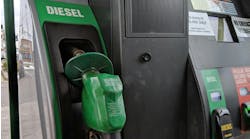In 2018, when I was on the stage at the end of Shell’s Starship press conference, I said there was unfinished business with the project. While Shell did an admirable job with Starship 1.0, there were some glitches with several things, including the cruise control on the vehicle and some of the aerodynamic devices not working as planned.
To their credit, the people at Shell went back to the drawing board and began working on Starship 2.0. The cab from the original Starship was used, but a new chassis and drivetrain were added along with new safety and fuel-efficiency upgrades.
Starship embarked on a cross-country journey across the U.S. from San Diego to Jacksonville, Florida—following the same route as the original Starship. This time, Shell also added a second, shorter 400-mile run. NACFE monitored and verified both routes.
The results
In the cross-country run, Starship 2.0 achieved a freight ton efficiency of 254 ton-miles per gallon. Just as a reminder, according to Shell, freight ton efficiency is the most relevant statistic for judging the energy intensity associated with moving cargo from point A to point B since it combines the weight of the cargo being moved with the amount of fuel consumed. But for those who like mpg, Starship 2.0 achieved 10.8 mpg on the cross-country run.
The cross-country demonstration had Starship 2.0 fully loaded, but that is only one scenario for the way trucks operate in North America. The 400-mile short-haul return-to-base run took place in North Carolina with a trailer loaded to 17.5 tons. The average fuel economy on this run was 12 mpg and the freight ton efficiency was 210 ton-miles per U.S. gallon of fuel.
I want to commend Shell on finishing what it started in 2018 with Starship 1.0 by undertaking another run with the remade Starship 2.0. This demonstrates the company’s commitment to showing that efficiency improvements are possible with diesel-powered vehicles and offers us and the entire industry a road map to achieving great “freight” efficiency.
While we are moving to a zero-emissions future, there's no reason for us to stop trying to improve diesel-powered trucks. Given the trade cycles of many fleets and the fact that battery electric vehicles are not yet ready for every duty cycle, diesels will be around for quite a while longer. So, a big thank you to Shell for embarking on Starship 2.0 and for letting NACFE be part of the adventure. Let’s all keep working toward zero-emissions and decarbonizing trucking with a variety of efficient technologies. After all, 10.8 and 12 mpg are some very impressive numbers. I challenge fleet managers to move their fuel-economy averages closer to those numbers.
Michael Roeth has worked in the commercial vehicle industry for nearly 30 years, most recently as executive director of the North American Council for Freight Efficiency. He serves on the second National Academy of Sciences Committee on Technologies and Approaches for Reducing the Fuel Consumption of Medium and Heavy-Duty Vehicles and has held various positions in engineering, quality, sales, and plant management with Navistar and Behr/Cummins.




